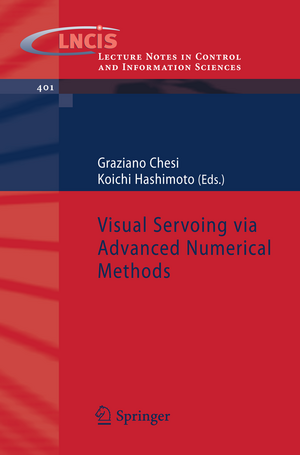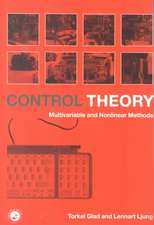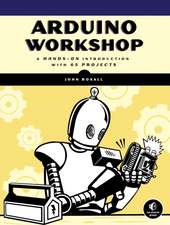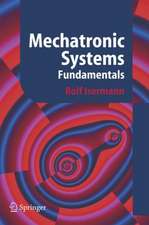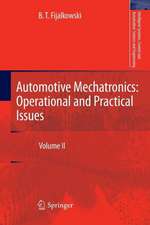Visual Servoing via Advanced Numerical Methods: Lecture Notes in Control and Information Sciences, cartea 401
Editat de Graziano Chesi, Koichi Hashimotoen Limba Engleză Paperback – 15 mar 2010
Din seria Lecture Notes in Control and Information Sciences
- 20%
 Preț: 318.81 lei
Preț: 318.81 lei - 15%
 Preț: 633.53 lei
Preț: 633.53 lei - 20%
 Preț: 555.04 lei
Preț: 555.04 lei - 18%
 Preț: 959.98 lei
Preț: 959.98 lei - 15%
 Preț: 696.02 lei
Preț: 696.02 lei - 18%
 Preț: 957.75 lei
Preț: 957.75 lei - 18%
 Preț: 782.42 lei
Preț: 782.42 lei - 18%
 Preț: 894.46 lei
Preț: 894.46 lei - 18%
 Preț: 1111.34 lei
Preț: 1111.34 lei - 20%
 Preț: 347.08 lei
Preț: 347.08 lei - 11%
 Preț: 468.56 lei
Preț: 468.56 lei - 20%
 Preț: 657.16 lei
Preț: 657.16 lei -
 Preț: 387.75 lei
Preț: 387.75 lei -
 Preț: 397.97 lei
Preț: 397.97 lei -
 Preț: 379.86 lei
Preț: 379.86 lei -
 Preț: 394.71 lei
Preț: 394.71 lei -
 Preț: 390.84 lei
Preț: 390.84 lei - 15%
 Preț: 642.51 lei
Preț: 642.51 lei - 15%
 Preț: 648.24 lei
Preț: 648.24 lei -
 Preț: 381.59 lei
Preț: 381.59 lei -
 Preț: 385.62 lei
Preț: 385.62 lei - 15%
 Preț: 641.53 lei
Preț: 641.53 lei - 15%
 Preț: 699.28 lei
Preț: 699.28 lei - 20%
 Preț: 333.72 lei
Preț: 333.72 lei -
 Preț: 379.68 lei
Preț: 379.68 lei -
 Preț: 484.98 lei
Preț: 484.98 lei -
 Preț: 390.63 lei
Preț: 390.63 lei -
 Preț: 423.73 lei
Preț: 423.73 lei -
 Preț: 393.13 lei
Preț: 393.13 lei -
 Preț: 382.36 lei
Preț: 382.36 lei - 18%
 Preț: 737.26 lei
Preț: 737.26 lei -
 Preț: 392.37 lei
Preț: 392.37 lei - 15%
 Preț: 645.28 lei
Preț: 645.28 lei - 15%
 Preț: 637.93 lei
Preț: 637.93 lei -
 Preț: 383.50 lei
Preț: 383.50 lei -
 Preț: 397.59 lei
Preț: 397.59 lei -
 Preț: 407.19 lei
Preț: 407.19 lei -
 Preț: 406.80 lei
Preț: 406.80 lei -
 Preț: 385.08 lei
Preț: 385.08 lei -
 Preț: 387.38 lei
Preț: 387.38 lei -
 Preț: 387.38 lei
Preț: 387.38 lei -
 Preț: 394.71 lei
Preț: 394.71 lei -
 Preț: 391.02 lei
Preț: 391.02 lei -
 Preț: 383.71 lei
Preț: 383.71 lei -
 Preț: 396.62 lei
Preț: 396.62 lei -
 Preț: 382.95 lei
Preț: 382.95 lei -
 Preț: 396.02 lei
Preț: 396.02 lei -
 Preț: 385.08 lei
Preț: 385.08 lei -
 Preț: 384.48 lei
Preț: 384.48 lei -
 Preț: 381.59 lei
Preț: 381.59 lei
Preț: 647.40 lei
Preț vechi: 761.65 lei
-15% Nou
Puncte Express: 971
Preț estimativ în valută:
123.89€ • 130.27$ • 102.36£
123.89€ • 130.27$ • 102.36£
Carte tipărită la comandă
Livrare economică 17 aprilie-01 mai
Preluare comenzi: 021 569.72.76
Specificații
ISBN-13: 9781849960885
ISBN-10: 1849960887
Pagini: 400
Ilustrații: XXIV, 400 p. With online files/update.
Dimensiuni: 155 x 235 x 25 mm
Greutate: 0.61 kg
Ediția:2010
Editura: SPRINGER LONDON
Colecția Springer
Seria Lecture Notes in Control and Information Sciences
Locul publicării:London, United Kingdom
ISBN-10: 1849960887
Pagini: 400
Ilustrații: XXIV, 400 p. With online files/update.
Dimensiuni: 155 x 235 x 25 mm
Greutate: 0.61 kg
Ediția:2010
Editura: SPRINGER LONDON
Colecția Springer
Seria Lecture Notes in Control and Information Sciences
Locul publicării:London, United Kingdom
Public țintă
ResearchCuprins
Vision.- Catadioptric Stereo with Planar Mirrors: Multiple-view Geometry and Camera Localization.- Empirical Characterization of Convergence Properties for Kernel-based Visual Servoing.- High-speed Visual Feedback Control for Grasping and Manipulation.- Human-machine Cooperative Manipulation with Vision-based Motion Constraints.- Luminance: A New Visual Feature for Visual Servoing.- Visual Servoing for Beating Heart Surgery.- Estimation and Path-Planning.- A Variational Approach to Trajectory Planning in Visual Servoing.- Estimation of Homography Dynamics on the Special Linear Group.- Image Measurement Errors in Visual Servoing: Estimating the Induced Positioning Error.- Multicriteria Analysis of Visual Servos through Rational Systems, Biquadratic Lyapunov Functions, and LMIs.- Path-Planning for Visual Servoing: A Review and Issues.- Single Camera Structure and Motion Estimation.- Visual Servoing and Pose Estimation with Cameras Obeying the Unified Model.- Control.- Gradient Projection Methods for Constrained Image-based Visual Servo.- Image-based Visual Servo Control Design with Multi-Constraint Satisfaction.- Points-based Visual Servoing with Central Cameras.- Sensor-based Trajectory Deformation: Application to Reactive Navigation of Nonholonomic Robots.- Unicycle-like Robots with Eye-in-Hand Monocular Cameras: From PBVS towards IBVS.- Unmanned Helicopter Control via Visual Servoing with Occlusion Handling.- Visual Servoing via Nonlinear Predictive Control.
Notă biografică
Graziano Chesi received the Laurea in Information Engineering from the University of Florence (1997) and the Ph.D. in Systems Engineering from the University of Bologna (2001). He was with the Department of Information Engineering of the University of Siena (2000-2006) and then joined the Department of Electrical and Electronic Engineering of the University of Hong Kong (2006-present). He was a visiting scientist at the Department of Engineering of the University of Cambridge (1999-2000) and at the Department of Information Physics and Computing of the University of Tokyo (2001-2004). Dr. Chesi was the recipient of the Best Student Award of the Faculty of Engineering of the University of Florence (1997). He was Associate Editor of the IEEE Transactions on Automatic Control (2005-2009) and Guest Editor of the Special Issue on Positive Polynomials in Control of the IEEE Transactions on Automatic Control (2009). Since 2007 he is Associate Editor of Automatica. He is the Founder and Chair of the Technical Committee on Systems with Uncertainty of the IEEE Control Systems Society. He is author of the book "Homogeneous Polynomial Forms for Robustness Analysis of Uncertain Systems" (Springer, 2009) and editor of the book "Visual Servoing via Advanced Numerical Methods" (Springer, 2010). He is first author in more than 100 technical publications.
Koichi Hashimoto is a Professor at the Graduate School of Information Sciences, Tohoku University. He received his BS, MS and DE degrees from Osaka University in 1985, 1987 and 1990, respectively. His major research interests include visual servoing, parallel processing and biological systems.
Prof. Hashimoto is a member of IEEE, RSJ, SICE, ISCIE, IPSJ and JSME. He is the Editor of the book Visual Servoing: Real-Time Control of Robot Manipulators Based on Visual Sensory Feedback, World Scientific, 1993, and the book Control and Modeling of Complex Systems, Birkhäuser, 2003.
Prof. Hashimoto is a member of IEEE, RSJ, SICE, ISCIE, IPSJ and JSME. He is the Editor of the book Visual Servoing: Real-Time Control of Robot Manipulators Based on Visual Sensory Feedback, World Scientific, 1993, and the book Control and Modeling of Complex Systems, Birkhäuser, 2003.
Caracteristici
Provides readers with extensive research in important method of robotic sensing and control Results reported in the text are supported by video and other on-line material Takes account of the most recent developments in video and computer technology Facilitates the construction of robots which interact with the environment in more human-like ways – reducing the need for specially designed environments
